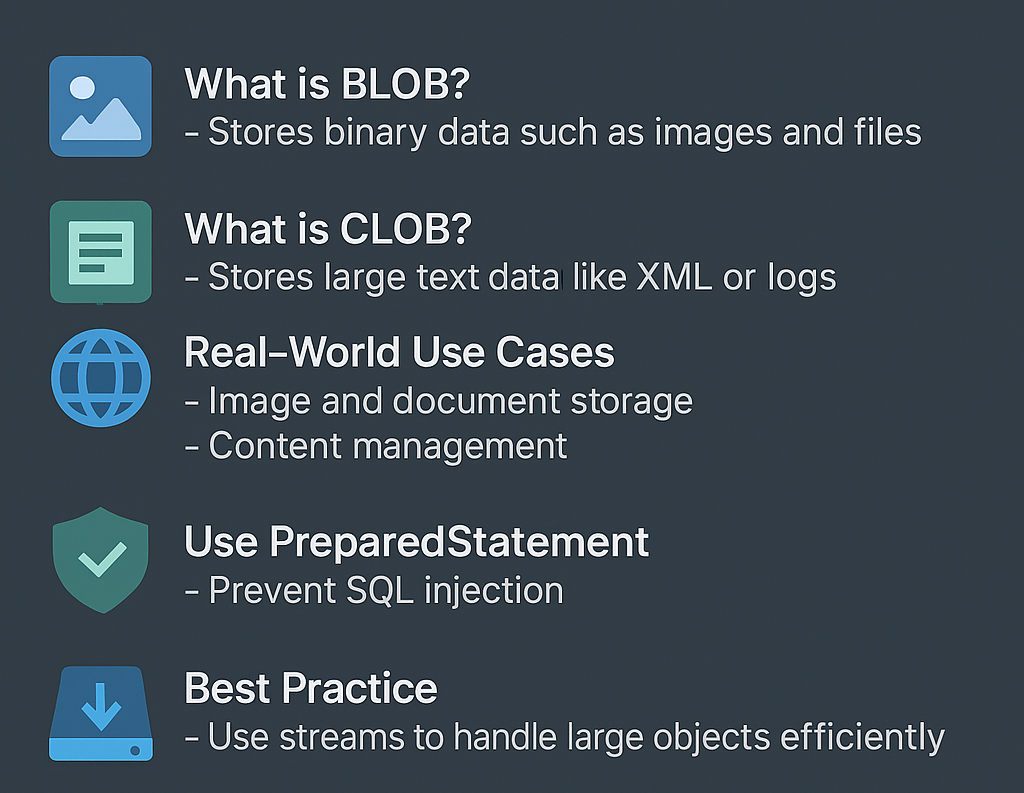Introduction
Handling large objects in databases often requires working with BLOB (Binary Large Object) and CLOB (Character Large Object) fields. JDBC provides robust APIs to store and retrieve binary data like images, videos, and large text files efficiently.
Why BLOB and CLOB Matter
- Binary Data Storage: For images, audio, video, and documents.
- Large Text Storage: For XML, JSON, logs, and documents.
- Enterprise Applications: Media libraries, CMS, and reporting systems rely on LOB handling.
Core Concepts
What is BLOB?
- BLOB (Binary Large Object): Stores binary data such as images, videos, and files.
What is CLOB?
- CLOB (Character Large Object): Stores large text data like XML, JSON, or logs.
BLOB/CLOB Workflow
Java App → Connection → PreparedStatement → BLOB/CLOB Field → Database
Real-World Use Cases
- Image Storage: Profile pictures, product images.
- Document Management: PDFs, Word files.
- Content Management: Articles, blogs with rich text.
- Media Applications: Audio/video libraries.
Working with BLOB in JDBC
Storing BLOB
import java.io.*;
import java.sql.*;
public class BlobExample {
public static void main(String[] args) throws Exception {
String url = "jdbc:mysql://localhost:3306/testdb";
String user = "root";
String password = "password";
String sql = "INSERT INTO files (name, data) VALUES (?, ?)";
try (Connection conn = DriverManager.getConnection(url, user, password);
PreparedStatement ps = conn.prepareStatement(sql);
FileInputStream fis = new FileInputStream("image.jpg")) {
ps.setString(1, "profile.jpg");
ps.setBinaryStream(2, fis, fis.available());
ps.executeUpdate();
System.out.println("BLOB stored successfully.");
}
}
}
Retrieving BLOB
String sql = "SELECT data FROM files WHERE name = ?";
try (PreparedStatement ps = conn.prepareStatement(sql)) {
ps.setString(1, "profile.jpg");
try (ResultSet rs = ps.executeQuery()) {
if (rs.next()) {
try (InputStream is = rs.getBinaryStream("data");
FileOutputStream fos = new FileOutputStream("output.jpg")) {
byte[] buffer = new byte[1024];
int bytesRead;
while ((bytesRead = is.read(buffer)) != -1) {
fos.write(buffer, 0, bytesRead);
}
}
}
}
}
Working with CLOB in JDBC
Storing CLOB
String sql = "INSERT INTO documents (title, content) VALUES (?, ?)";
try (PreparedStatement ps = conn.prepareStatement(sql);
FileReader reader = new FileReader("article.txt")) {
ps.setString(1, "Sample Article");
ps.setCharacterStream(2, reader);
ps.executeUpdate();
System.out.println("CLOB stored successfully.");
}
Retrieving CLOB
String sql = "SELECT content FROM documents WHERE title = ?";
try (PreparedStatement ps = conn.prepareStatement(sql)) {
ps.setString(1, "Sample Article");
try (ResultSet rs = ps.executeQuery()) {
if (rs.next()) {
try (Reader reader = rs.getCharacterStream("content")) {
BufferedReader br = new BufferedReader(reader);
String line;
while ((line = br.readLine()) != null) {
System.out.println(line);
}
}
}
}
}
Statement vs PreparedStatement for BLOB/CLOB
| Feature | Statement | PreparedStatement |
|---|---|---|
| SQL Injection Safety | Vulnerable | Safe with parameter binding |
| Handling Streams | Limited | Full support for binary/text |
| Performance | Re-parsed each time | Precompiled, efficient reuse |
Common Mistakes and Anti-Patterns
- Storing huge files directly: Better to use file storage and store references.
- Loading entire BLOB into memory: Use streams to handle large files.
- Ignoring database limits: Check database-specific BLOB/CLOB size constraints.
- Using Statement instead of PreparedStatement: Leads to SQL injection risk.
Security Implications
- Validate file types and sizes before storing.
- Use parameterized queries to prevent SQL injection.
- Restrict access to sensitive LOB data.
Performance and Scalability
- Use streaming to handle large objects efficiently.
- Consider hybrid approach: store files on disk and path in DB.
- Use connection pooling for concurrent LOB operations.
Best Practices
- Always use
PreparedStatementfor LOB handling. - Use streams for large files to avoid memory issues.
- Separate BLOB/CLOB storage from critical transactional data if possible.
- Compress large files before storing when applicable.
Real-World Analogy
Think of a BLOB as a sealed package (binary data) and a CLOB as a book (character data). JDBC acts as the courier that securely transfers these packages between your application and the database.
Conclusion & Key Takeaways
- BLOB handles binary data; CLOB handles large text.
- Always use streaming and PreparedStatement for efficiency and security.
- Combine with best practices for scalable, production-ready systems.
FAQ
-
What is BLOB in JDBC?
A data type used to store binary large objects like images and files. -
What is CLOB in JDBC?
A data type used to store character large objects like text and XML. -
Which JDBC class handles BLOB?
Blobinterface andgetBinaryStream()/setBinaryStream()methods. -
Which JDBC class handles CLOB?
Clobinterface andgetCharacterStream()/setCharacterStream()methods. -
Is it good to store images in a database?
For small images, yes. For large files, consider storing paths. -
Does BLOB/CLOB work with all databases?
Yes, supported by major RDBMS like MySQL, PostgreSQL, Oracle. -
Can I use PreparedStatement for BLOB/CLOB?
Yes, it's the recommended approach. -
What are common BLOB size limits?
Depends on the DB: MySQL up to 4GB, PostgreSQL supports large objects. -
How to handle large files without memory issues?
Use streaming APIs instead of reading into memory. -
Can I compress BLOB data in JDBC?
Yes, you can compress before storing and decompress after retrieval.
